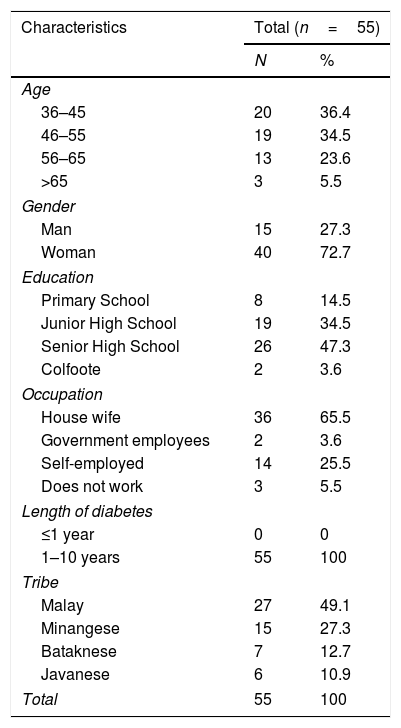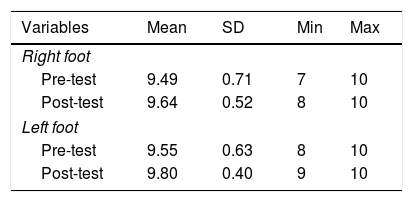To measure foot sensitivity and blood glucose levels among diabetic patients as measures of improvement pre and post Apiyu massage.
MethodQuasi experimental research was employed to measure foot sensitivity and blood glucose levels before and after APIYU massage for fifty-five (55) purposive sampled consented adult patients with diabetes from Rejosari and Langsat Health Centers in Pekanbaru Riau, Indonesia. The intervention was given about three times in a week for thirty (30) minutes.
ResultRevealed that there were significant differences between measures before and after massage using the Apiyu tool on: (a) mean sensitivity levels for pre-tests and post-tests on the right foot (pre-test 9.49, post-test 9.64; p-value=0.011) and the left foot (pre-test 9.55, post-test 9.80; p-value=0.004), and (b) blood glucose levels (pre-test 271.6, post-test 220.7; p-value=0.001).
ConclusionThe APIYU massage was proven effective for improving foot sensitivity and reducing blood glucose among diabetic patients.
Diabetes mellitus (DM) is a state of chronic hyperglycemia accompanied by a variety of metabolic disorders due to hormonal disorders.2 The International Diabetes Federation (IDF) estimates that Indonesia is ranked 3rd largest DM patient in the world by 2025.4 Changes in people's unhealthy lifestyles such as rarely doing physical activities, often consuming high cholesterol, sweet foods are the causes. This condition is one of the factors causing the high prevalence of DM patients in Pekanbaru Riau. Along with the increasing prevalence it will increase DM complications if there are no serious efforts to prevent, and improve in appropriate treatment and care.
One way that can reduce the blood sugar level and increase in foot sensitivity is reflexology. Reflexology therapy can have an effect in helping to improve disturbed blood circulation and can increase the sensitivity of the hands and feet in patients with DM.1 The area of reflection is a region of nerve fissure that is spread throughout the related organs.3
Data obtained in general from interviews with 24 members of the DM from Rejosari and Langsat Health Centers Pekanbaru, obtained data that 19 of 24 people among them did not know of any complications from DM. They are not aware of foot exercises that can stimulate insulin production and can prevent foot ulcers.
Based on the data and problems above researchers are interested in developing APIYU's reflexology complementary therapy designed by the researchers themselves as one of the therapies that can increase the sensitivity of the foots and reduce the blood glucose levels of type II DM.
MethodThis study used a Quasy Experiment with experimental and control group by purposive sampling technique. This research is done by pre-test and post-test. The study was carried out in the working area of the Rejosari and Langsat Health Center, Pekanbaru. Survey research was collected the sensitivity level of foot type II DM patients, doing APIYU foot massage and measuring the sensitivity of DM patients’ foot. The populations in this study were all DM patients who went to the Rejosari and Langsat Pekanbaru Health Center. The inclusion criteria for the sample in this study were diagnosed with DM disease, at least 30 years old, respondents living in Pekanbaru, willing to become research respondents.
Results- 1.
Univariate analysis
Table 1 show the most age was the respondent at the end of the adult age (34–45 years). The majority of respondents were women with a total of 40 people (72.7%), and high school educated with a total of 26 people (47.3%). The majority of respondents’ jobs are housewife as many as 36 people (65.5%). All respondents suffered from DM for 1–10 years. The majority of the respondent tribes were Malay as many as 27 people (49.1%).
Distribution of respondent characteristics.
| Characteristics | Total (n=55) | |
|---|---|---|
| N | % | |
| Age | ||
| 36–45 | 20 | 36.4 |
| 46–55 | 19 | 34.5 |
| 56–65 | 13 | 23.6 |
| >65 | 3 | 5.5 |
| Gender | ||
| Man | 15 | 27.3 |
| Woman | 40 | 72.7 |
| Education | ||
| Primary School | 8 | 14.5 |
| Junior High School | 19 | 34.5 |
| Senior High School | 26 | 47.3 |
| Colfoote | 2 | 3.6 |
| Occupation | ||
| House wife | 36 | 65.5 |
| Government employees | 2 | 3.6 |
| Self-employed | 14 | 25.5 |
| Does not work | 3 | 5.5 |
| Length of diabetes | ||
| ≤1 year | 0 | 0 |
| 1–10 years | 55 | 100 |
| Tribe | ||
| Malay | 27 | 49.1 |
| Minangese | 15 | 27.3 |
| Bataknese | 7 | 12.7 |
| Javanese | 6 | 10.9 |
| Total | 55 | 100 |
Based on Table 2 the experimental group the mean value of the respondent's right foot before being given the intervention was 9.49 with a standard deviation (SD) of 0.71 and after being given intervention the mean value was 9.64 with a standard deviation of 0.52. The mean value of the respondent's left foot sensitivity before given an intervention is 9.55 with a standard deviation of 0.63 and after giving the intervention the mean value is 9.80 with a standard deviation of 0.40.
Table 3 show the mean value of respondents’ blood sugar levels before given an intervention was 271.62mg/dl with a standard deviation (SD) of 79.43mg/dl and after the intervention the mean was 220.75mg/dl with a standard deviation of 71.83. The results of this study indicate that the average respondent in the experimental group before the intervention had blood sugar levels worth 271.62mg/dl and after the intervention had a mean blood sugar level with a value of 220.75mg/dl.
- 2.
Bivariate analysis
Table 4 in the experimental group conducted the Wilcoxon test found the results of data analysis obtained p-value 0.011 and 0.004<(α=0.05). So it can conclude that there was difference in the mean sensitivity of the right and left foot before and after foot massage using APIYU.
Table 5 show that the mean blood sugar levels of respondents before intervention that is 271.62mg/dl with a SD of 79.43 and after giving the intervention a mean of 220.75mg/dl with a SD of 71.83. The results of data analysis obtained p-value 0.001<(α=0.05). So it can be concluded that there were differences in mean blood sugar levels before and after massage using APIYU.
Discussion- 1.
Univariate analysis
- a.
Age
The most age is the respondents who are elderly (36–55 years old) as many as 20 people (36.4%). The results of this study are in accordance with the research of Hasneli found that the age of many affected by DM is age 45–60 as much as 63.3% of the total respondents.1 Age is a natural risk factor.
- b.
Gender
The results showed that most respondents were women of 40 people (72.7%). The incidence of DM in women is higher than men because women physically have a greater chance of increasing BMI (Body Mass Index) than men.5
- c.
Education
The most results were high school with total 26 people (47.3%). According to the assumption of researchers, knowledge possessed by a person will also influence his attitude in making decisions to maintain health status.
- d.
Occupation
The majority of respondents’ jobs were housewife (65.5%). Most respondents have jobs as housewife as many as 13 respondents (40.6%).5
- e.
Length of DM
All respondents suffered from DM for 1–10 years.
- f.
Tribe
The majority of the respondent tribes were Malay as many as 27 people (49.1%).
- 2.
Bivariate analysis
- a.
Comparison of the sensitivity of the right and left foot before and after a foot massage using an APIYU in the experimental group.
The mean sensitivity of the right and left foot of the respondent before given intervention is 9.49 and 9.55 with SD of 0.71 and 0.63 and after given intervention 9.64 and 9.80 were obtained with the SD of 0.52 and 0.40. The results of data analysis obtained p-value 0.011 and 0.004<(α=0.05). So, there are differences in the mean sensitivity of the right and left feet before and after foot massage using APIYU in the experimental group.
- b.
Comparison of blood sugar levels before and after a foot massage using APIYU in the experimental group.
Based on the Wilcoxon test, the mean blood sugar levels of respondents before given an intervention of 271.62mg/dl with a standard deviation of 79.43mg/dl and after the intervention the mean value was 220.75mg/dl with a standard deviation of 71.83. The results of data analysis obtained p-value 0.001<(α=0.05). So it can be concluded that there was a difference in the mean blood sugar levels before and after massage using APIYU in the experimental group.
ConclusionsThe results revealed that the most age is the respondents in the early elderly age (46–55 years) as many as 20 people (36.4%), the sex of the most respondents is women with the number of 40 people (72.7%), the majority of them are high school educated with total of 26 people (47.3%), the majority of respondents’ jobs were housewife as many as 36 people (65.5%), all respondents suffered from DM for 1–10 years, and the majority of the respondents’ tribes were Malay as many as 27 people (49.1%).
The results of statistical tests for sensitivity of the right and left foots were obtained p-value 0.011 and 0.004<(α=0.05). So it can be concluded that there was a difference in the mean sensitivity of the right and left foots before and after foot massage using APIYU in the experimental group. Statistical test results using the Wilcoxon test for blood sugar levels when obtained p-value 0.001<(α=0.05). So it can be concluded that there was a difference in the mean blood sugar levels before and after massage using APIYU in the experimental group.
Thank you to DIKTI which had funding this project, LPPM Riau University, Faculty of Nursing Riau University, my family, fellow researchers, and assistants who have been willing to spend their time and provide input to researchers.
Peer-review of abstracts of the articles is under the responsibility of the Scientific Committee of Riau International Nursing Conference 2018. Full-text and the content of it is under responsibility of authors of the article.











